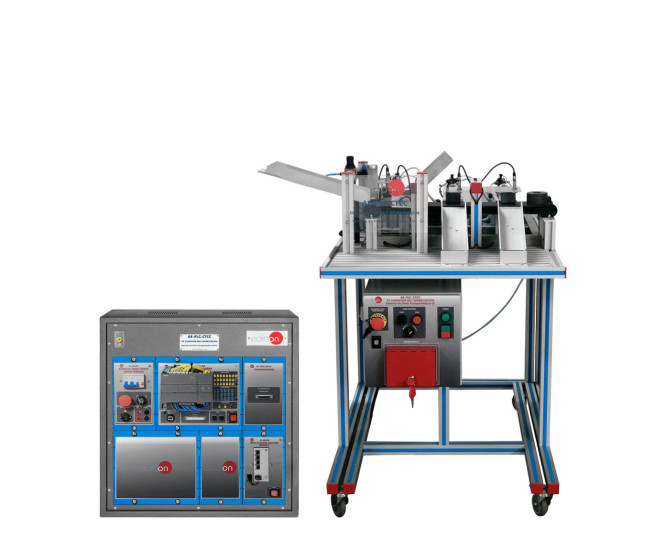The DC Conveyor Belt Workstation, "AE-PLC-CTCC", explores DC conveyor system management, including piece classification. It features industrial components like PLC, sensors, etc., enabling control of an automatic DC-powered conveyor system with sorting capabilities.
The "AE-PLC-CTCC" is composed by a conveyor, four presence sensors, motor positioner, DC motor driver and DC motor to a complete control of the conveying.
The "AE-PLC-CTCC" workstation is designed as a modular system to facilitate the understanding.
The main components are:
- The PLC: is composed by the CPU limit and all extra modules needed to perform a corrent working of the workstation and all the extra modules needed to perform a correct working of the workstation.
- The Control Panel: with start/stop button, emergency pushbutton, reset button, light indicators to show current state of the process, etc.
- The Pneumatic Circuit: contains the required solenoid valves, the pressure components, the filters and regulators to assure the appropriate working of the unit.
- The Workstation: it is composed by real industrial components used by the rotary table systems such as reed sensors, presence sensors, DC motor, inductive sensors, rotary table with 8 positions, etc.
The pneumatic circuit and the workstation are distributed in the following modules:
- Air Treatment System: it contains a filter-regulator block with a water trap and shut-off valve to control the air pressure input to the unit. Includes a dual-scale pressure gauge to visualize the pressure level supplied to the unit.
- Parts Feeding Section: contains a sloped ramp to supply parts to the system. The parts are supplied to the unit one by one through a double-acting cylinder. The two inputs of the double-acting cylinder each have an adjustable airflow valve with a bypass to regulate the cylinder speed.
- Parts Verification Section: designed to detect whether the parts supplied to the unit are made of metal or PVC. The parts verification module checks this feature for further classification of unwanted parts. This verification is performed using an inductive sensor.
- Parts Displacement Section: the displacement of parts is carried out by a conveyor belt with a DC motor to the sorting area.
- Parts Sorting Section: designed to sort parts of different materials, if the part is metal, the first sorting cylinder is activated, and the part will be stored in the metal parts area, and if the part is PVC, the second sorting cylinder is activated, and the part will be stored in the PVC parts area. The sorting cylinder is a double-acting cylinder. The two inputs of the double-acting cylinder each have an adjustable airflow valve with a bypass to regulate the cylinder speed.
- Signaling Tower: contains green, yellow, and red LED lights to indicate the system's status.
- Solenoid Valve Block: is a distributor block of pneumatic valves with three solenoid valves, two of which function as 5/2 monostable solenoid valves and two as 5/2 bistable solenoid valves.
- Electrical Terminal Block: contains all accessible and identified unit signals for manual unit checking. The electrical terminal block has color-coded terminals to help the user identify the type of each signal, and it also contains the name of each signal.
 Настройки cookie
Настройки cookie













